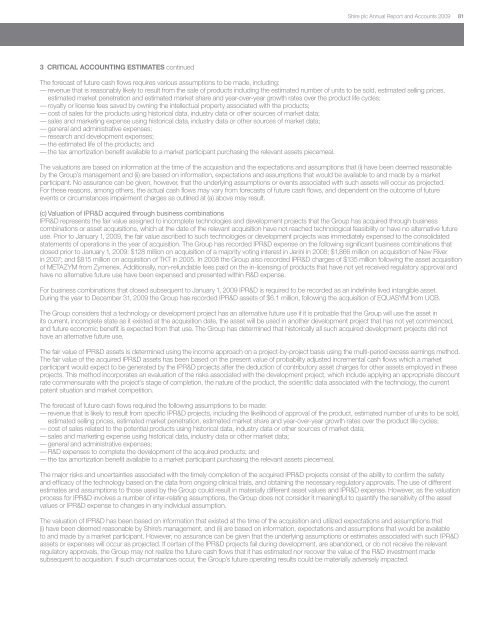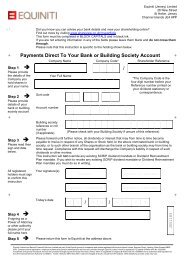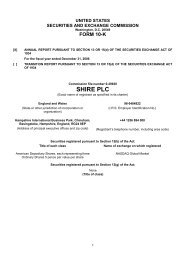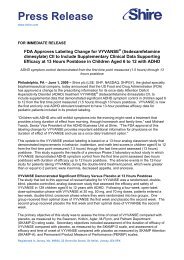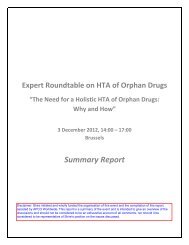7817 Annual Report 2009.qxd - Shire
7817 Annual Report 2009.qxd - Shire
7817 Annual Report 2009.qxd - Shire
Create successful ePaper yourself
Turn your PDF publications into a flip-book with our unique Google optimized e-Paper software.
<strong>Shire</strong> plc <strong>Annual</strong> <strong>Report</strong> and Accounts 2009813 CRITICAL ACCOUNTING ESTIMATES continuedThe forecast of future cash flows requires various assumptions to be made, including:— revenue that is reasonably likely to result from the sale of products including the estimated number of units to be sold, estimated selling prices,estimated market penetration and estimated market share and year-over-year growth rates over the product life cycles;— royalty or license fees saved by owning the intellectual property associated with the products;— cost of sales for the products using historical data, industry data or other sources of market data;— sales and marketing expense using historical data, industry data or other sources of market data;— general and administrative expenses;— research and development expenses;— the estimated life of the products; and— the tax amortization benefit available to a market participant purchasing the relevant assets piecemeal.The valuations are based on information at the time of the acquisition and the expectations and assumptions that (i) have been deemed reasonableby the Group’s management and (ii) are based on information, expectations and assumptions that would be available to and made by a marketparticipant. No assurance can be given, however, that the underlying assumptions or events associated with such assets will occur as projected.For these reasons, among others, the actual cash flows may vary from forecasts of future cash flows, and dependent on the outcome of futureevents or circumstances impairment charges as outlined at (a) above may result.(c) Valuation of IPR&D acquired through business combinationsIPR&D represents the fair value assigned to incomplete technologies and development projects that the Group has acquired through businesscombinations or asset acquisitions, which at the date of the relevant acquisition have not reached technological feasibility or have no alternative futureuse. Prior to January 1, 2009, the fair value ascribed to such technologies or development projects was immediately expensed to the consolidatedstatements of operations in the year of acquisition. The Group has recorded IPR&D expense on the following significant business combinations thatclosed prior to January 1, 2009: $128 million on acquisition of a majority voting interest in Jerini in 2008; $1,866 million on acquisition of New Riverin 2007; and $815 million on acquisition of TKT in 2005. In 2008 the Group also recorded IPR&D charges of $135 million following the asset acquisitionof METAZYM from Zymenex. Additionally, non-refundable fees paid on the in-licensing of products that have not yet received regulatory approval andhave no alternative future use have been expensed and presented within R&D expense.For business combinations that closed subsequent to January 1, 2009 IPR&D is required to be recorded as an indefinite lived intangible asset.During the year to December 31, 2009 the Group has recorded IPR&D assets of $6.1 million, following the acquisition of EQUASYM from UCB.The Group considers that a technology or development project has an alternative future use if it is probable that the Group will use the asset inits current, incomplete state as it existed at the acquisition date, the asset will be used in another development project that has not yet commenced,and future economic benefit is expected from that use. The Group has determined that historically all such acquired development projects did nothave an alternative future use.The fair value of IPR&D assets is determined using the income approach on a project-by-project basis using the multi-period excess earnings method.The fair value of the acquired IPR&D assets has been based on the present value of probability adjusted incremental cash flows which a marketparticipant would expect to be generated by the IPR&D projects after the deduction of contributory asset charges for other assets employed in theseprojects. This method incorporates an evaluation of the risks associated with the development project, which include applying an appropriate discountrate commensurate with the project’s stage of completion, the nature of the product, the scientific data associated with the technology, the currentpatent situation and market competition.The forecast of future cash flows required the following assumptions to be made:— revenue that is likely to result from specific IPR&D projects, including the likelihood of approval of the product, estimated number of units to be sold,estimated selling prices, estimated market penetration, estimated market share and year-over-year growth rates over the product life cycles;— cost of sales related to the potential products using historical data, industry data or other sources of market data;— sales and marketing expense using historical data, industry data or other market data;— general and administrative expenses;— R&D expenses to complete the development of the acquired products; and— the tax amortization benefit available to a market participant purchasing the relevant assets piecemeal.The major risks and uncertainties associated with the timely completion of the acquired IPR&D projects consist of the ability to confirm the safetyand efficacy of the technology based on the data from ongoing clinical trials, and obtaining the necessary regulatory approvals. The use of differentestimates and assumptions to those used by the Group could result in materially different asset values and IPR&D expense. However, as the valuationprocess for IPR&D involves a number of inter-relating assumptions, the Group does not consider it meaningful to quantify the sensitivity of the assetvalues or IPR&D expense to changes in any individual assumption.The valuation of IPR&D has been based on information that existed at the time of the acquisition and utilized expectations and assumptions that(i) have been deemed reasonable by <strong>Shire</strong>’s management, and (ii) are based on information, expectations and assumptions that would be availableto and made by a market participant. However, no assurance can be given that the underlying assumptions or estimates associated with such IPR&Dassets or expenses will occur as projected. If certain of the IPR&D projects fail during development, are abandoned, or do not receive the relevantregulatory approvals, the Group may not realize the future cash flows that it has estimated nor recover the value of the R&D investment madesubsequent to acquisition. If such circumstances occur, the Group’s future operating results could be materially adversely impacted.


